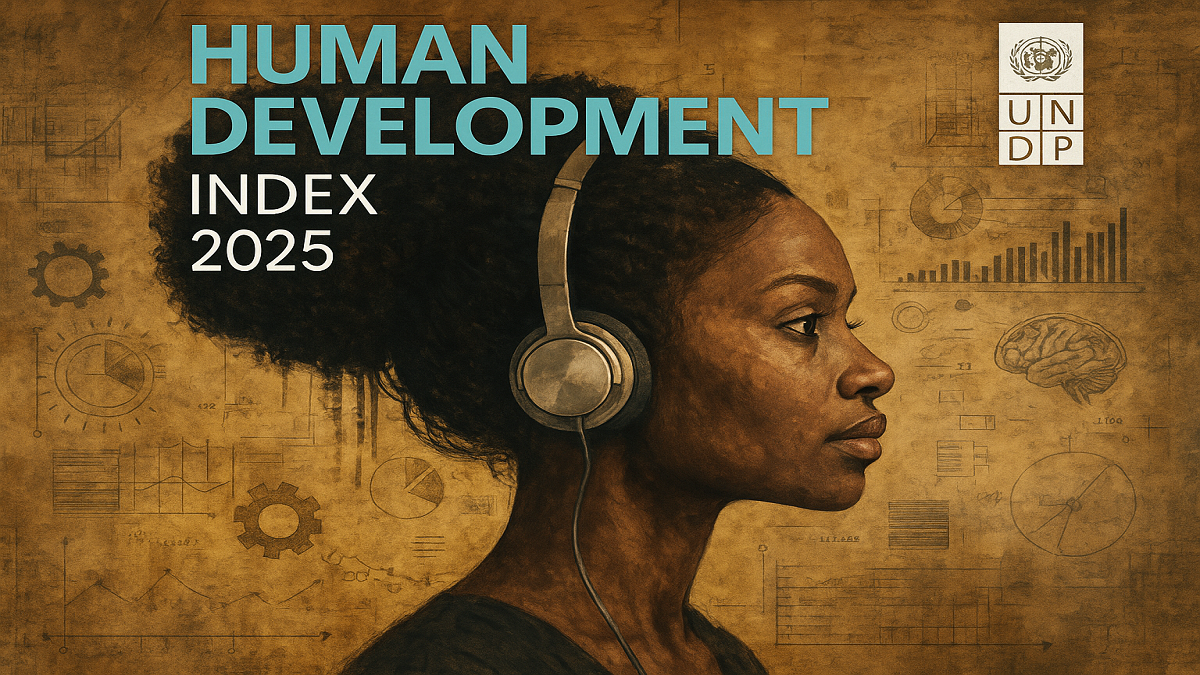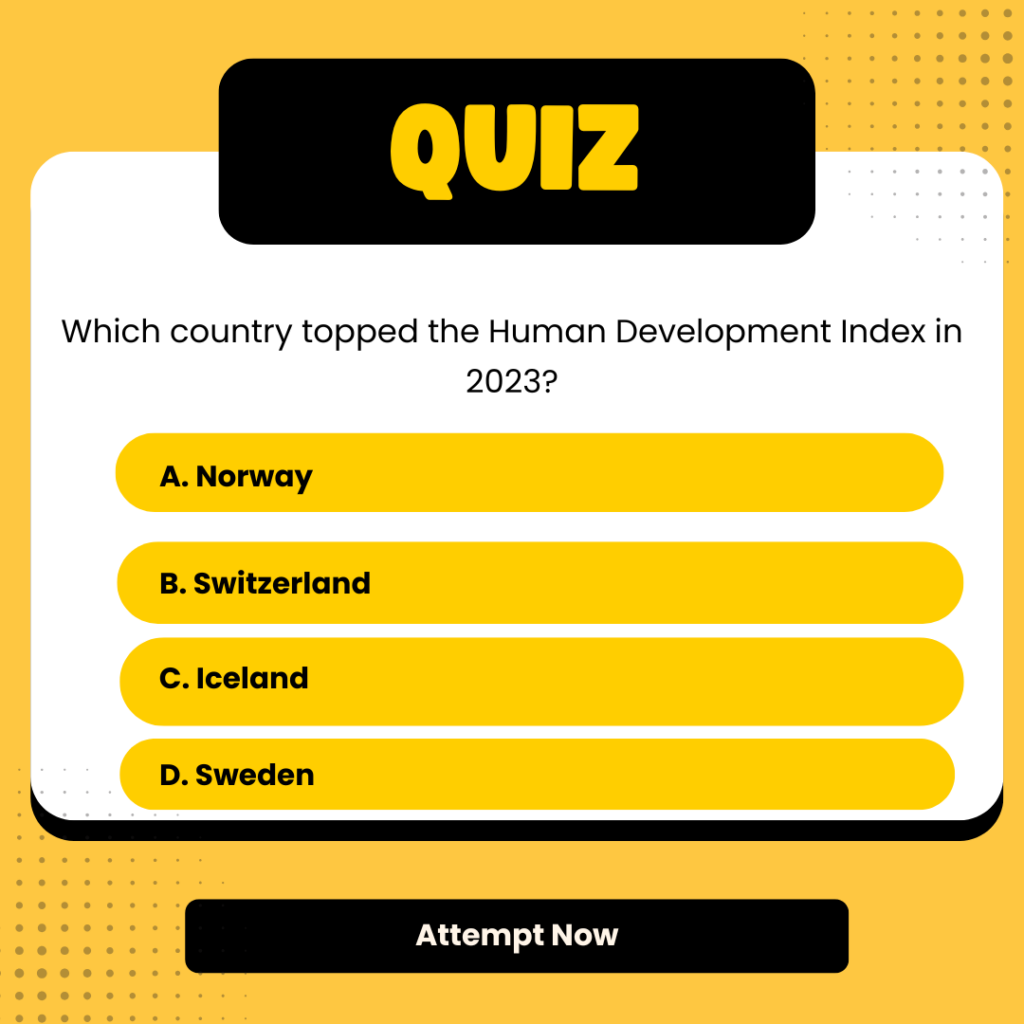India improved its rank to 130 out of 193 countries on the Human Development Index (HDI) in 2023, according to the UNDP Human Development Report 2025. This marks a three-place rise from its 2022 rank of 133. India also demonstrated notable improvement in reducing gender inequality, climbing from 108 (out of 166 countries) in 2022 to 102 out of 193 countries in 2023 on the Gender Inequality Index (GII). The theme of the Human Development Report “A matter of choice: People and possibilities in the age of AI”.
Despite this progress, India scored 0.874 on the Gender Development Index (GDI), placing it among Group 5 countries which are considered to have low success in closing the gender gap. On the HDI front, with a value of 0.685, India remains in the medium human development category, but is inching closer to the threshold of high human development, set at 0.700.
Top 10 Country in Human Development Index 2025
| HDI Rank (2023) | Country | HDI Value (2023) |
|---|---|---|
| 1 | Iceland | 0.972 |
| 2 | Norway | 0.970 |
| 2 | Switzerland | 0.970 |
| 4 | Denmark | 0.962 |
| 5 | Germany | 0.959 |
| 5 | Sweden | 0.959 |
| 7 | Australia | 0.958 |
| 8 | Hong Kong, China (SAR) | 0.955 |
| 8 | Netherlands | 0.955 |
| 10 | Belgium | 0.951 |
Bottom 10 Country in Human Development Index 2025
| HDI Rank (2023) | Country | HDI Value (2023) |
|---|---|---|
| 184 | Yemen | 0.470 |
| 185 | Sierra Leone | 0.467 |
| 186 | Burkina Faso | 0.459 |
| 187 | Burundi | 0.439 |
| 188 | Mali | 0.419 |
| 188 | Niger | 0.419 |
| 190 | Chad | 0.416 |
| .. | Central African Republic | 0.414 |
| 192 | Somalia | 0.404 |
| 193 | South Sudan | 0.388 |
Key Contributors to HDI Growth
India’s HDI value has increased by over 53% since 1990, outpacing global and South Asian averages. The improvement is attributed to economic growth and targeted social protection and welfare programs.
India’s life expectancy at birth rose from 71.7 years in 2022 to 72 years in 2023, the highest since the index’s inception. In 1990, it stood at 58.6 years, signaling a robust recovery from the pandemic. Key national health schemes like the National Rural Health Mission, Ayushman Bharat, Janani Suraksha Yojana, and Poshan Abhiyaan have played crucial roles in improving health outcomes.
Education and Income Trends
In terms of education, expected years of schooling have remained stable at about 13 years, while mean years of schooling rose marginally from 6.6 to 6.9 years. Initiatives such as the Right to Education Act, Samagra Shiksha Abhiyan, and the National Education Policy 2020 have been central to these gains.
On the economic front, Gross National Income (GNI) per capita increased to $9,047 in 2023 from $8,475 in 2022 (at 2021 PPP $). Since 1990, GNI per capita has more than quadrupled from $2,167.22. Programs like MGNREGA, Jan Dhan Yojana, and digital inclusion initiatives have contributed significantly to poverty reduction, helping 135 million people escape multidimensional poverty between 2015-16 and 2019-21.
Challenges: Inequality and Gender Gaps
Despite the progress, challenges remain. Inequality reduces India’s HDI by 30.7%, one of the highest losses in the region. While inequality in health and education has lessened, income and gender disparities persist. Female labor force participation and political representation remain low. However, the recent constitutional amendment reserving one-third of legislative seats for women provides hope for systemic change.
Regional and Global Comparison
India shares its HDI rank of 130 with Bangladesh, while Nepal is at 145 and Bhutan at 125. These countries are also in the medium human development category. In contrast, Pakistan dropped from 164 to 168, and Afghanistan improved to 181, both falling under the low human development category. Countries like China (78) and Sri Lanka (89) continue to maintain their status in the high human development category.
At the top of the HDI rankings are Iceland (0.972), followed by Norway and Switzerland. South Sudan ranks last at 193, with a score of 0.388.
Global HDI Trends and the Role of AI
Globally, the 2025 Human Development Report titled “A Matter of Choice: People and Possibilities in the Age of Artificial Intelligence” shows that human development progress has stalled to a 35-year low. Projections for 2024 indicate stalled HDI progress across all regions, with 2023 showing the smallest annual HDI increase since 1990 (excluding pandemic years).
However, there is optimism. A new UNDP survey shows that 60% of people are hopeful AI will create new job opportunities. Especially in low- and medium-HDI countries, 70% expect AI to improve productivity, and two-thirds anticipate using AI in education, health, or work within the next year.
According to Achim Steiner, UNDP Administrator, unless progress picks up, the 2030 target for achieving very high human development could be delayed by decades, making the world more divided and vulnerable.




 CareEdge State Rankings 2025: Maharashtr...
CareEdge State Rankings 2025: Maharashtr...
 Top 10 Most Expensive Cities To Live Aro...
Top 10 Most Expensive Cities To Live Aro...
 Reliance Beats Apple, Ranks 2nd in Futur...
Reliance Beats Apple, Ranks 2nd in Futur...







